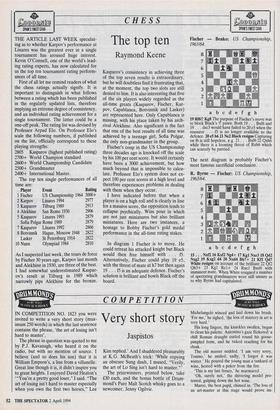.COOL4,1k1
SPAIN'S FINEST CAVA
CHESS
4914 JiLL/C2M1111 SPAIN'S FINEST CAVA
The top ten
Raymond Keene
THE ARTICLE LAST WEEK speculat- ing as to whether Karpov's performance at Linares was the greatest ever in a single tournament has aroused huge interest. Kevin O'Connell, one of the world's lead- ing rating experts, has now calculated for us the top ten tournament rating perform- ances of all time.
First of all let me remind readers of what the chess ratings actually signify. It is important to distinguish in what follows between a rating which has been published in the regularly updated lists, therefore implying an extreme degree of consistency, and an individual rating achievement for a single tournament. The latter could be a one-off peak. The rating list was devised by Professor Arpad Elo. On Professor Elo's scale the following numbers, if published on the list, officially correspond to these playing strengths: 2805 Kasparov (highest published rating) 2700+ World Champion standard 2600+ World Championship Candidate 2500+ Grandmaster 2400+ International Master.
'The top ten single performances of all time are: Player Event Rating 1 Fischer US Championship 1964 3000+ 2 Karpov Linares 1994 2977 3 Kasparov Tilburg 1989 2913 4 Alekhine San Remo 1930 2906 5 Kasparov Linares 1993 2879 Sofia Polgar Rome 1989 2879 7 Kasparov Linares 1992 1866 8 Botvinnik Hague, Moscow 1948 2822 Lasker St Petersburg 1914 2822 10 Nunn Olympiad 1984 2810 As I suspected last week, the tours de force by Fischer 30 years ago, Karpov last month and Alekhine in 1930, are three of the best. I had somewhat underestimated Kaspar- ov's result at Tilburg in 1989 which narrowly pips Alekhine for the bronze. Kasparov's consistency in achieving three of the top seven results is extraordinary, but he will doubtless find it frustrating that, at the moment, the top two slots are still denied to him. It is also interesting that five of the six players widely regarded as the all-time greats (Kasparov, Fischer, Kar- pov, Capablanca, Botvinnik and Lasker) are represented here. Only Capablanca is missing, with his place taken by his arch- rival Alekhine. Also significant is the fact that one of the best results of all time was achieved by a teenage girl, Sofia Polgar, the only non-grandmaster in the group.
Fischer's coup in the US Championship three decades ago is knocked off the scale by his 100 per cent score. It would certainly have been a 3000 achievement, but how much beyond that is impossible to calcu- late. Professor Elo's system does not ex- pect 100 per cent scores at a high level and therefore experiences problems in dealing with them when they occur.
I have indicated before that when a player is on a high roll and is clearly in line for a massive score, the opposition tends to collapse psychically. Wins pour in which are not just miniatures but also brilliant miniatures. Here are two instances, a homage to Bobby Fischer's gold medal performance in the all-time rating stakes.
In diagram 1 Fischer is to move. He could retreat his attacked knight but Black would then free himself with . . . f5. Alternatively, Fischer could play 19 e5, with the threat of mate at h7 but then again 19. . . f5 is an adequate defence. Fischer's solution is brilliant and bowls Black off the board. Benko: US Championship, Fischer — 1963164.
19 Rf6!! KgS The purpose of Fischer's move was to block Black's 'f' pawn. Both 19 . . . Bxf6 and 19 , dxc3 would have failed to 20 e5 when the resource . . . f5 is no longer available to the defence. 20 e5 h6 21 Ne2 Black resigns Capturing
on f6 is still hopeless, e.g. 21 . Idxf6 22 Qxh6 while there is a looming threat of Rxh6 which can scarcely be parried.
The next diagram is probably Fischer's most famous sacrificial conclusion.
R. Byrne — Fischer: US Championship, 1963164.
15. . . Nxf2 16 Kxf2 Ng4+ 17 Kg1 Nxe3 18 Qd2 Nxg2 19 1Cxg2 d4 20 Nxd4 131)7+ 21 Kfl Qd7 White resigns on account of the brilliant 22 Qf2 Qh3+ 23 Kgl Rel+ 24 Rxel Bxd4 with imminent mate,. When White resigned a number of spectating grandmasters were still unsure as to why Byrne had capitulated.


























































 Previous page
Previous page